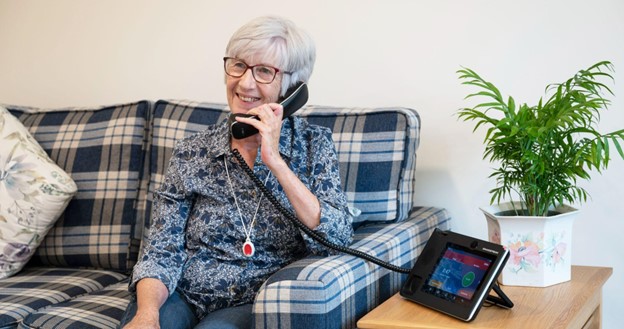How telecare is leading a retirement revolution
With the youngest Baby Boomers turning 60 by 2024, the most comfortable, competent and confident tech users are heading into retirement, with the likelihood that they’ll also live for longer (opens new window). Meeting this tech-savvy generation’s accommodation expectations will be essential for people working on retirement living specifications – and will need a shift in mindset.
Sarah Watts, Corporate Sales Director at Tunstall Healthcare, explains how including the future user in planning technology in retirement housing is the logical solution. Taking the time to explore options on an individual basis also means that users and families of users can search for a set of products that fully wraps around the individual and their needs.
Self-management key to successful ageing
Future retirement communities need to be an attractive option and a safe environment – as well as being fulfilling and enjoyable for the resident. Research shows that giving a person autonomy over long-term health and care - described in the Journal of the Royal Society of Medicine as self-management (opens new window) - is key to ‘successful ageing’.
“Emphasising patient responsibility, and acting in concert with providers, self-management seems a promising strategy for managing long-term conditions, – moving beyond education to teaching individuals to actively identify and solve problems … Self-management also shows potential in prevention by encouraging healthy behaviours and strategies.”
‘Same as before’ is not an option
Today’s assistive technology does away with ‘one size fits all’ solutions. While it’s often the case that the facilities they choose will have a technology system in place, it is increasingly common that this can be personalised with additional devices to suit their individual requirements when they move in. Just as well, because Baby Boomers will not expect to live in – or with – the same facilities they’ve seen when visiting older family members.
The increase in life expectancy means that not only is the aforementioned generation likely to live longer, but their parents will too. By the time a 65 - 70 year old is considering their retirement accommodation, their mothers and fathers could realistically also be in community living. But while they may have this in common, the level of technology and their demands will be entirely different.
Not in case of emergency, but everyday use
In a more conventional retirement community, it’s worth remembering that a housing communication system (opens new window) is already for more than assistance calls or crises. Free internal calls between residents encourage connectivity, and for those living alone, this can have a positive impact on their wellbeing, whether someone calls just to check in, or for a more lengthy conversation.

And with almost 4.2m people aged 65 and over living alone (opens new window), connection is key. Extra assurance and support for single residents allows them to keep their independence for longer.
When specified and applied correctly, connected care can enrich everyday lives. When it comes to personal safety and security, telecare provides immediate response and effective reassurance (opens new window) to the user. But from a social point of view, staying connected and having an easily accessible means to do so reduces loneliness, which has been associated to help support with the onset of later-life conditions, such as dementia (opens new window).
An easy step
The generation that has just retired - or is likely to retire in the next ten years - will probably already have smart solutions in their own homes. Given this, they may want to start incorporating telecare into their current living arrangements.
For couples living together, there may be circumstances in a household where one member of a partnership is still in employment, while providing informal care for their spouse. In these cases, the ‘worker’ can confidently carry on with their outside work, safe in the knowledge that their partner at home is safe, secure and connected.

Telecare that evolves with the user
For those who can fund their own domestic connected care set-up, it takes the pressure away from an already-strained public sector. It also means that the solutions will evolve with their requirements, from devices that enhance their lifestyle to safety equipment that protects them.
Telecare is not designed to take away somebody’s independence, it is designed to prolong independence and promote engagement. Above all, it encourages the user to take responsibility for their own care (opens new window), while they can, for as long as possible. Put simply, when it comes to the future of retirement living, the sooner we start, the better.
Sarah Watts is the Corporate Sales Director at Tunstall Healthcare. For more information on preparing the ageing population for the future of retirement living, please visit www.tunstall.co.uk/retirement-living
And, if you found this blog of interest, do have a look at our technology enabled care and housing webpages. Split into 3 main sections, here you will find a number of resources on TAPPI, Going Digital and Smart Housing and Telecare.

Comments
Add your comment